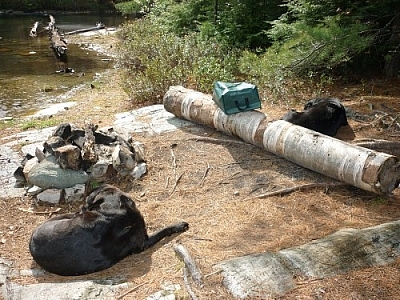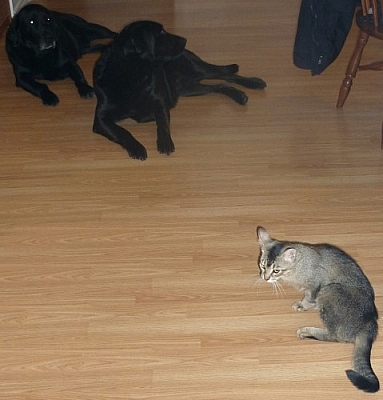About a month ago, Marc and I hiked Killarney’s La Cloche Silhouette loop trail, but not without some consequences to our pets. We have two cats, Grooby-doo and Currdles, and two black labs, Fetcher and Maggie. This trip affected one of each, and although Fetcher is fine now, I can’t say the same for Currdles (frowny face).
Oh, pet woes is me!

Fetcher’s problems are of a different nature than Currdles’s. We didn’t even realize he had any until the end of the second day of our hike.
While making camp, I’d been scratching Fetcher’s head and behind his ears when I felt a bump. Uh oh. Digging into the fur and separating the hairs close to his skin, I saw what all hikers dread: a tick! Its head was already buried under Fetcher’s skin. Thankfully, I always carry tweezers in my first aid kit.
In fact, the day before leaving for the trip, my mother had asked me about our first aid kit. When I began listing the items I’d made sure we had, she stopped me at tweezers, wondering why we would need those. I had my answer ready in a flash, having had to remove a tick once before, out on BC’s Sunshine Coast Trail, from a guy’s ribs not far below his heart.

But taking a tick out of a dog is not the same thing! Dogs move a lot, and a second dog sniffing about doesn’t help. I wasn’t able to remove the tick without breaking its head. But in cleaning off the wound I noticed a bit of yellowish scab come off, and through the week as I monitored his healing progress, I didn’t notice any redness or irritation, so I didn’t let myself worry about infection.
Back home, I researched ticks and found some conflicting info (the best came from this BC vet’s website). I think the tick had been there probably since the start of our trip since it was fully attached, its head buried, no legs visible, and engorged (whether fully or only partially, I have no idea). So it may have passed disease-infected fluids to Fetcher, but from what I’ve read, he should be fine since the wound is fully healed, there’s no redness or irritation, the scab’s gone, and there’s barely a bump left.

But the confusion comes from tick identification. Was it a Lyme disease-carrying species? So I called my cousin, an Ottawa-area vet, who told me that so long as the wound was healing well, it should be fine, but that since the tick was engorged, I could choose to bring Fetcher in for blood tests four to six weeks after the bite had occurred if I was still concerned. As far as tick identification goes, she said that can be tricky without a microscope, and their clinic sends ticks to the lab for testing to be identified correctly.
However, she also said that ticks have become more common in these parts over the past five years, and that they carry diseases other than Lyme. She even saw a case of Rocky Mountain Spotted Fever! Clearly, that’s not normal in Ontario… So, she stressed the importance of daily tick checks for those who spend a lot of time outdoors — human or animal!
And unfortunately, it seems that Lyme disease isn’t taken seriously by Canadian doctors: apparently we don’t have that here (veterinarians aren’t so silly). So, if a person is bitten by a tick and contracts Lyme disease, it’s likely they will have to travel to the States for treatment. A dog will be treated by the neighbourhood vet, though. Woof!
My cousin did recommend buying a tick twister to make the removal process easier, and that’s one gear tip I’m sure to take.
Update: The other thing we now do is spray ourselves and the dogs with our homemade natural bug spray, which helps to repel ticks.
Making sure Fetcher was ok wasn’t our only problem when we got back from Killarney. We didn’t know until we got back that one of our cats went missing while we were away.

Grooby-doo is a couple years older than Currdles. They’ve both been vaccinated and Grooby’s been spayed for a long time, but we had to cancel Currdles’s appointment this spring and planned on rescheduling after our trip.
Not wanting to leave them in the apartment alone for five or six days, we thought of bringing them to my parents’ farm. Grooby would have been fine, but what about Currdles? My parents aren’t big on house pets, and I don’t let my cats roam outside if they’re not fixed. Plus, we didn’t want to separate them. So, we decided they could keep each other company in the empty chicken coop, where they could go in and out at their leisure. Better than being stuck inside, right?
You’d think. But Currdles had different ideas. Smaller than Grooby-doo, she crawled underneath the chicken coop from inside the fenced-in yard, then must have found a way out somehow, because she hasn’t been seen since the day we left (frowny face).

At first, my biggest concern was that she would come back pregnant, and of course I was embarrassed because I’m outspoken about the issue of spaying and neutering pets. I was worried about Currdles because I missed her, but I figured she would come back. Cats do that. Two of my sister’s cats have been quite adventurous, disappearing and returning a week later on more than one occasion.
That’s not to say I didn’t try to find her. I emailed all the neighbours, left out boxes for her, tried to coax her with tuna and treats. We call for her and look for her every time we go to my parents’ house. My parents have been keeping an eye out and have seen a grey cat, though we’re not sure it was her.

But now Currdles has been gone for a month. I’m still not afraid she’s dead or anything — I’ve heard of cats coming back after being gone for up to six months. But I’d like her to come back soon enough for me to take care of her and her kittens. And I miss her dreadfully. Grooby is Marc’s, Currdles is mine, and I miss her following my every step. I miss her annoying incessant meowing (which won’t be an issue now anyway!). I miss her stealing my chair every time I get up, and the cat hair all over the linen.
I’ve dreamed about her a few times this past week. We’re always in the same place, in the front yard at my parents’ place. I think she’ll be back soon.




Search Niackery
×